African violets or Saintpaulia are delightful plants that produce clusters of blue, white, or purple flowers over fuzzy leaves. They are perennials that can thrive in low light conditions and can bloom throughout the year.
However, caring for African violets is not everyone’s cup of tea. They can be fussy about their requirements. So, in this article, we will tell you all the secrets about caring for African violets and how you can keep them healthy and thriving.
African violets need bright, indirect light and enough humidity to thrive. To keep your African violets healthy, water them wherever the topsoil feels dry to touch, maintain the temperature range between 65-80°F and ensure that the potting mix is moist and nutritious for the plant.
African violets should be planted in a small pot with good drainage capacity and should get repotted every 1 or 2 years.
These plants are prone to many pest and disease problems, but most of these problems can be avoided by taking quick, immediate actions.
Though these flowering houseplants have a reputation of being fussy, they are not difficult to grow if we give them the right care.
This article will be a helpful guide to those who want to learn the basic care routine for African violets. It will also discuss the different problems of African violets and what you can do to fix them.
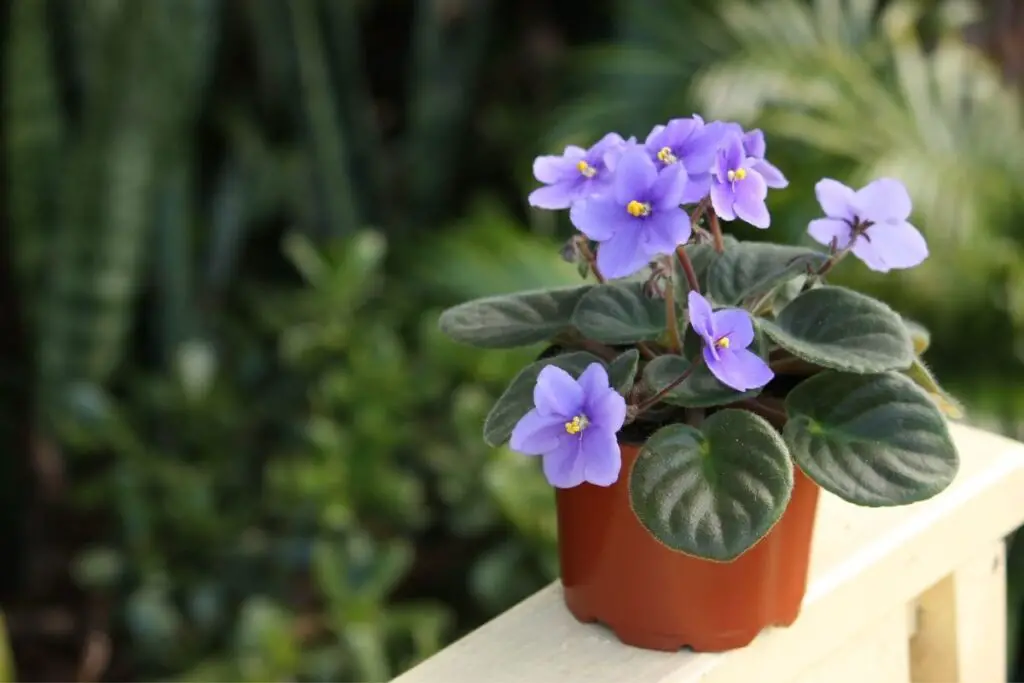
African violets overview
African violets are a member of the family Gesneriaceae, and they were botanically classified as Saintpaulia ionantha. They come from Tanzania and adjacent southeastern Kenya in eastern tropical Africa.
African violets are about 6-15cm tall and 6-30cm wide. The leaves of African violets are rounded to oval, finely-haired, and have fleshy textures. The blooms are 2-3 cm in diameter and have five petals that grow in clusters.
African violets are pretty hardy plants that grow well when provided with pleasant temperatures, a humid atmosphere, and protection from harsh sunlight.
Are African violets hard to care for plants?
African violets are often considered fussy about their care and needs. But they are probably the easiest plant to care of if you can keep a good check on their requirements.
A basic rule of African violet care is: treat them like your own child.
This means that never neglect them at any point in time, provide all of their necessaries when they need it, in moderation. This applies to watering, feeding, and choosing the environment for them.
They just need your attention, and they will surprise you with the most beautiful flowers and dark velvety leaves.
Are African violets indoor or outdoor plants?
African violets are popularly grown as houseplants because their leaves need to stay dry. These plants will only grow outside if they are provided with the right growing conditions.
If they are grown indoors, they will have enough space, light, and the right temperature.
They like to grow in warm and semi-humid climates, and cool temperatures outside can cause stunted growth in plants. They are also sensitive to direct sunlight and can get sunburns if kept outdoors.
They can be kept outdoors only in certain climates. They can only survive outside if they get everything in moderation. So ideally most suitable place for growing African violets is indoors only.
Also read: Can African Violets Grow Outside? (+Outdoor Care)
How often do African violets bloom?
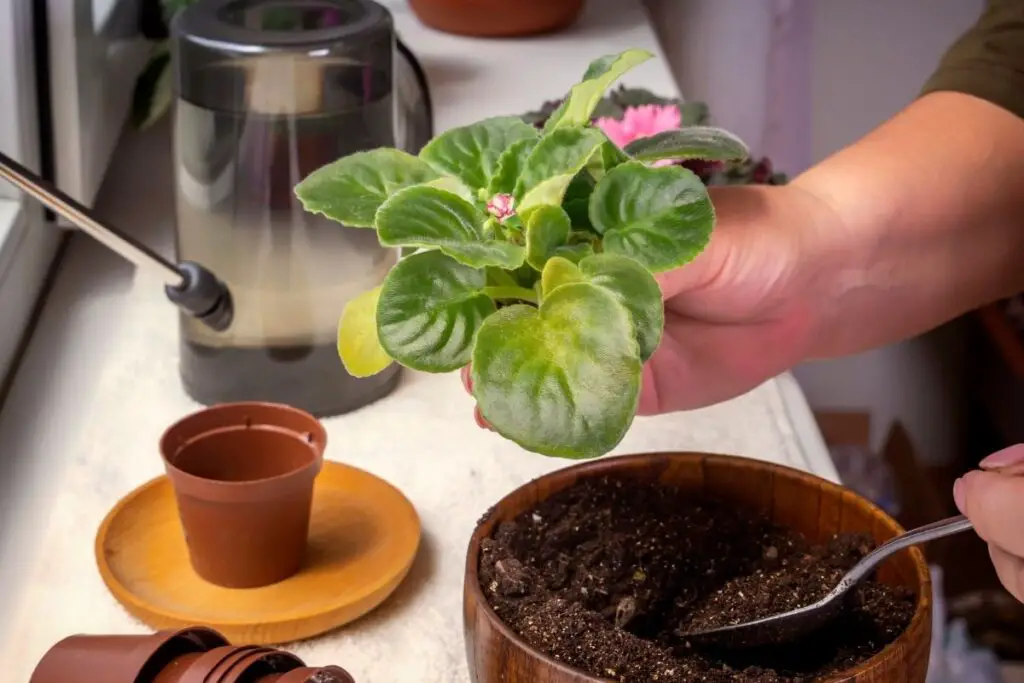
African violets can bloom throughout the year if they are provided with proper care. The healthy flower of African violets will last for 2 to 3 years, and they are capable of producing blooms regularly for 10 to 12 months in a year.
They can withhold their beautiful flowers even if one essential need isn’t met. So providing them with reasonable care is vital to maintain their healthy foliage and blooms.
Also read: How To Get An African Violet To Bloom? (Problems+Tips To Help)
African violets care
African violets require proper care and attention for their healthy growth. Even the slightest change in their care routine can be a stress factor for them.
They will need sufficient ideal temperature, enough humidity, bright indirect light, adequate watering, rich, well-drained potting mix, and additional nutrients for their growth.
Once you develop a routine of taking care of your African violets, you can grow them very easily. Let’s read on to find about the temperature, light, water, soil, and all the other requirements of African violets in detail.
African violets light requirements
African violets prefer bright, indirect light for growth. Keep them away from direct sunlight as they are sensitive to it, and their leaves can get scorched.
The light should be filtered with bright to medium intensity for African violets. Dark green leaves and leggy stems of African violets indicate that they receive too little light, whereas light green or bleached leaves receive too much light.
You can place your African violets in a window that gets bright indirect light most of the day, such as a window with western or southern exposure is best for African violets.
Ensure that the windows can provide 10-12 of light every day. You should keep the plants at least 1 foot away from the windowsill. Use a curtain to filter out the direct light.
If the windows lack sufficient lighting, you can use artificial lights like fluorescent or LED grow lights. Place grow lights 18 to 20 inches above the African violets.
During the winter season, they will need more light than they usually receive. Also, you should rotate your African violets once a week so that they can receive an equal amount of sunlight from all sides.
They will also need 8 hours of darkness each day to bloom.
Also read: What Kind Of Light Does An African Violet Need? (African Violet Light Requirements)
African violets water requirements
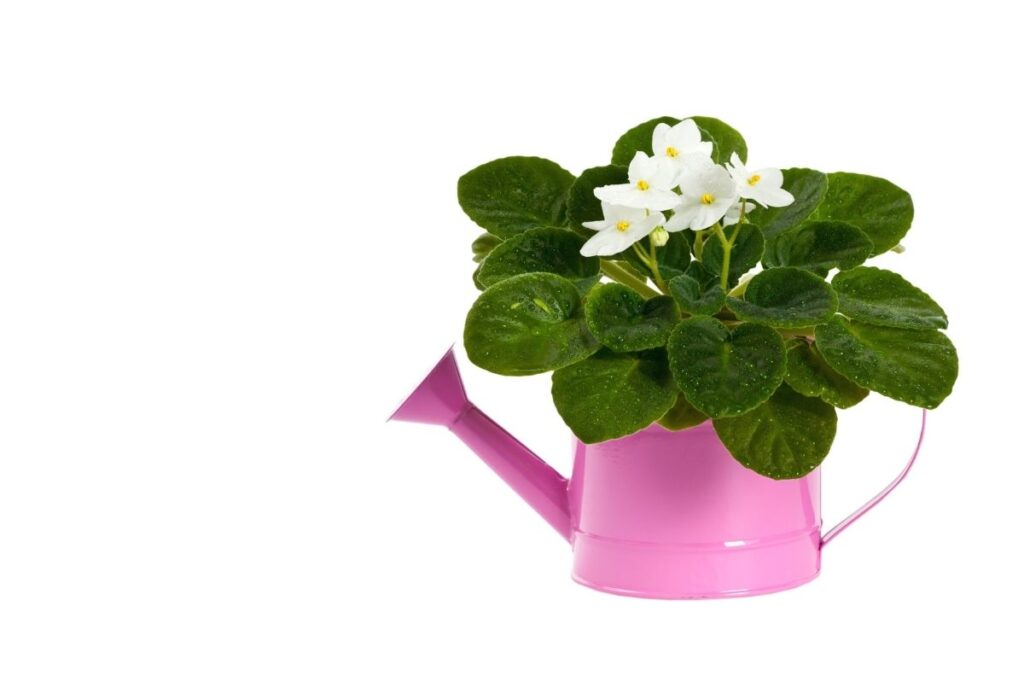
An important aspect of growing healthy African violets is watering. They will just need enough water to keep the potting mix moist and not soaked or saturated.
Water your African violets whenever the topsoil feels less moist or dry to the touch. The droopy leaves of African violets indicate that they need watering. If you find droopy leaves, water them immediately.
Avoid overwatering as the delicate roots of these plants need air, and a soggy mass of soil will not allow air penetration in the roots.
Always use room temperature water for watering them as cold water can cause leaves to curl and get spotted. Avoid using chlorinated water as it can cause leaf burn and diminished flowering.
You can water your African violets from the top using a baster or bottle with a narrow spout. Water them just above the potting mix and avoid getting water on the leaves.
The African violets are susceptible to root rot and foliar damage, so water them from the bottom and avoid wetting the leaves. To do bottom watering, fill the saucer with water, let the plant sit for about 30 minutes, and drain the excess water.
Also read: How Often Should African Violets Be Watered? (African Violet Water Requirements)
African violets pot
You should plant African violets in containers that have adequate holes for drainage. Proper drainage is essential for preventing root rot.
You can use both clay and plastic pots for growing African violets. A plastic pot will retain more moisture, whereas a clay pot will allow the air to penetrate the roots.
But sometimes salt can build up on clay pots, so you can protect the leaf stems by using aluminum foil to cover the rim of the clay pot.
The pot size for African violets should be one-third the diameter of the leaf spread.
Also read: What Kind Of Pot Does An African Violet Need? (Pot Type+Size)
Looking for gardening supplies? We have tested 100's of products before recommending them to you guys. Check out our best pick below:
| Image | Gardening Supplies | Best Price? |
|---|---|---|
 Top
Top Top
Top | Raised Garden Bed Kit | Check On Amazon |
 | XLUX Soil Moisture Meter, Plant Water Monitor, Soil Hygrometer Sensor for Gardening, Farming, Indoor and Outdoor Plants, No Batteries Required | No Results |
 Top
Top Top
Top | 82 Pcs Garden Tools Set and Extra Succulent Tools Set | Check On Amazon |
 | Joeys Garden Expandable Garden Hose with 8 Function Hose Nozzle, Lightweight Anti-Kink Flexible Garden Hoses, Extra Strength Fabric with Double Latex Core, (50 FT, Black) | No Results |
 Top
Top Top
Top | Dual Chamber Compost Tumbler | Check On Amazon |
 Top
Top Top
Top | Sunnyglade Plant Stakes | Check On Amazon |
 Top
Top Top
Top | Organic Cold Pressed Neem Seed Oil | Check On Amazon |
 Top
Top Top
Top | Mighty Mint Gallon :-Insect and Pest Control Peppermint Oil | Check On Amazon |
 Top
Top Top
Top | Scotts DiseaseEx Lawn Fungicide | Check On Amazon |
 Top
Top Top
Top | Jacks Classic 20-20-20 All Purpose Fertilizer | Check On Amazon |
 Top
Top Top
Top | 30,000 Seeds Pollinator Attracting Wildflower Mixture | Check On Amazon |
 Top
Top Top
Top | Survival Vegetable Seeds Garden Kit-Over 16,000 Seeds | Check On Amazon |
African violets soil mix
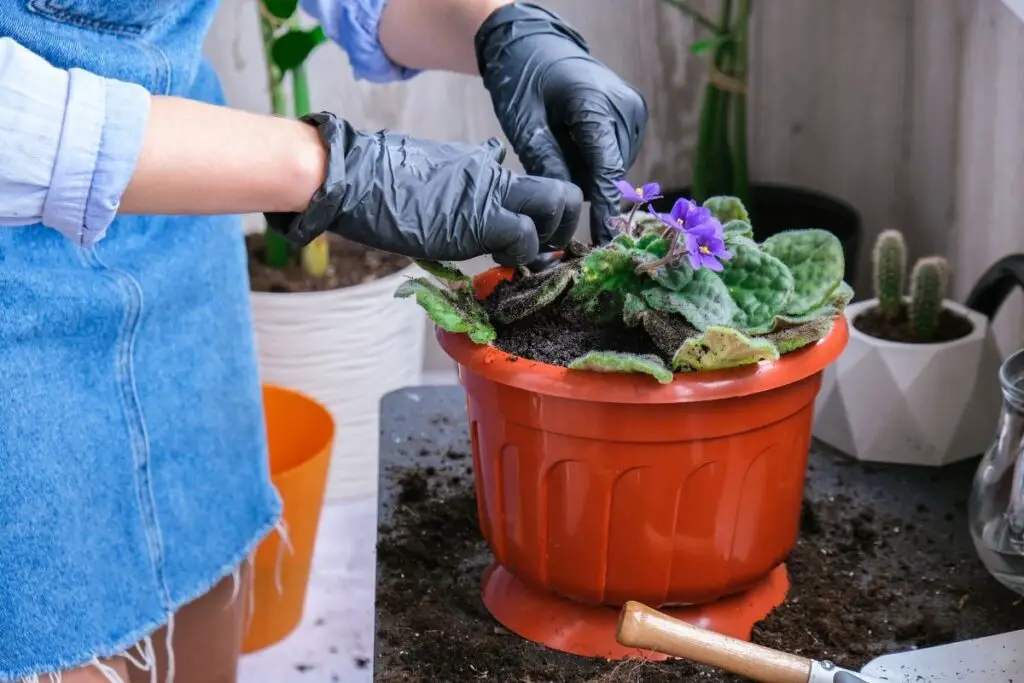
African violets prefer a soilless potting mix with a pH level of 6.2-6.5. You need to ensure that the potting mix for African violets is moist yet not dense, and it should also allow air to circulate the roots.
You can prepare the potting mix by mixing peat moss, perlite, compost, and vermiculite at a ratio of 1:1:1:1. You can go for commercials potting mix that should be light and a fluffy mixture.
The pot should have drainage holes that will allow the excess water to drain out. The soil must provide nutrition that the plant needs, aeration, and proper drainage to them.
You should repot your African violets in a fresh potting mix every year to keep them healthy.
Also read: What Kind Of Soil Is Best For African Violets? (+Best Soil Mix)
African violets fertilization requirements
African violets don’t require much fertilization in their life cycle and can suffer from over-fertilization issues. You must use fertilizers that are specially made for them and don’t overdo it.
During their active growing season, i.e., spring and summer, you should fertilize them every 2 weeks with phosphorus-rich plant food.
You can apply a standard balanced fertilizer with an NPK ratio of 15-30-15 for mature African violets. You can use this fertilizer each time they are watered. Add one-quarter of the fertilizer with water and allow the excess water to drain out from the container.
If you find fewer blooms and paler leaf color, it indicates that your plants are not getting sufficient fertilizers.
If your African violet potting mix is dry, you must moisten the soil with water to prevent root burn before fertilization. You should also flush your plant monthly with water to prevent excess fertilizer built up.
Also read: What Kind Of Fertilizer Is Good For African Violets? (+Best Picks)
African violets temperature
African violets thrive in room temperatures of 70-80°F during daytime and 65-70°F. Sudden fluctuations in temperatures can essentially damage these plants.
Do not let the temperature for African violets drop below 60°F and rise above 80°F.
High temperatures can cause their leaves to wilt and curl and flowers to drop off. To protect them from higher temperatures, you can increase the frequency of water it receives, promote high humidity around them, and avoid fertilization and repotting them.
Similarly, low temperatures can cause stunted growth, leaves starting to wilt, and the plant becomes more vulnerable to pests and diseases. To protect them from low temperatures, shift them to a warmer location in your house.
Move the plant close to the windows during the daytime to receive a good amount of sunlight and wash the dust from the leaves so that they can make maximum use of the available light.
Keep your African violets away from drafty windows in winter. You can even use fluorescent light to fulfill their light requirements in winters.
You can also keep a thermostat device to check the temperature and maintain the right temperature in the house for African violets.
Also read: African Violet Winter Care: Lighting, Watering, Fertilizing & More
African Violets Humidity
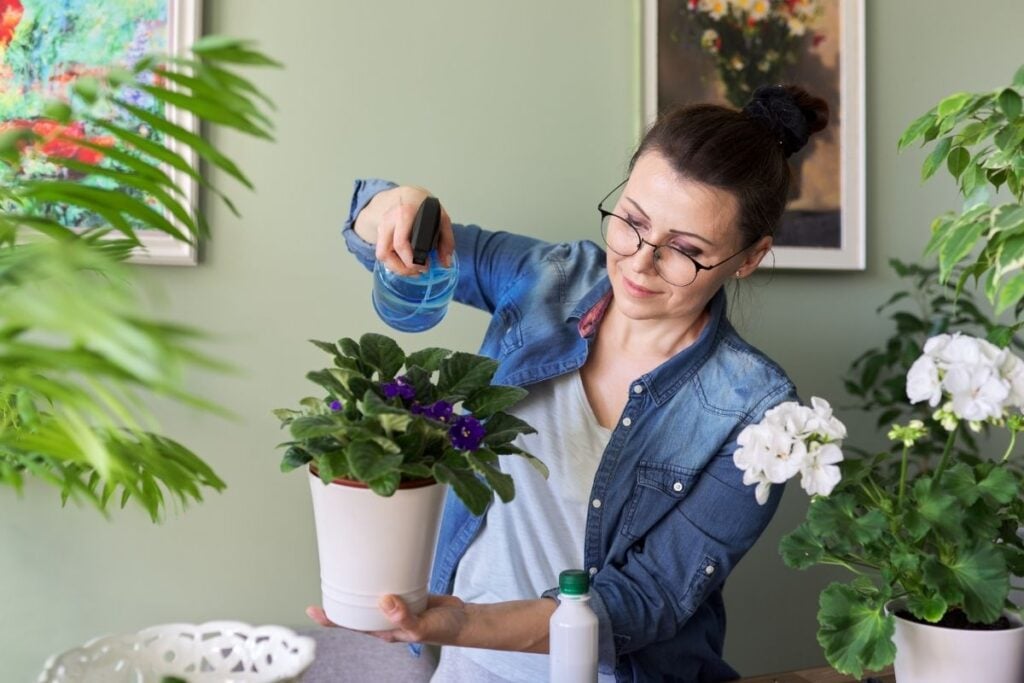
African violets need a humid atmosphere for growth. A humidity range of 50-60% is enough for them to thrive.
Low humidity can cause problems like dehydration in plants which causes their leaves to turn dry and desiccated. So at such times, it becomes necessary to increase humidity around them to bring them back to life.
You can group many plants to increase the humidity around them.
You can go for the bottom watering method, where you have to place your African violets on trays or dishes of pebbles and water and make sure that the plants don’t sit in water. The water will evaporate from the tray, thus creating a humid atmosphere around them.
You can use a humidifier device to increase humidity levels for them. Misting of African leaves is another good option. Keep them away from any heating sources such as furnaces or radiators.
Also read: Do African Violets Like Misting? (+Humidity Guide)
African violets repotting
Repotting African violets is beneficial for their long-lasting health. You can repot them in fresh soil every one or two years. Repotting of African violets doesn’t mean that you should report them in a larger pot. They generally like to be in a 4-5″ pot.
African violets like to be slightly root-bound, and repotting them to a large pot won’t help them. Always choose a pot that is 1/3 of the diameter of their leaf spread.
You should repot them when they start losing their lower leaves, forming a basic neck structure. To do repotting, remove the plant from the pot and use a sharp shear to cut the bottom of the roots.
Now, you can put your African violets back into the pot so that the bottom leaves are level with the rim of the plant. Now add a new potting mix to cover the pot rim. Water the plant usually less when it’s developing roots from the neck.
Also read: Do African Violets Like To Be Root Bound? (When To Repot)
African violets propagation
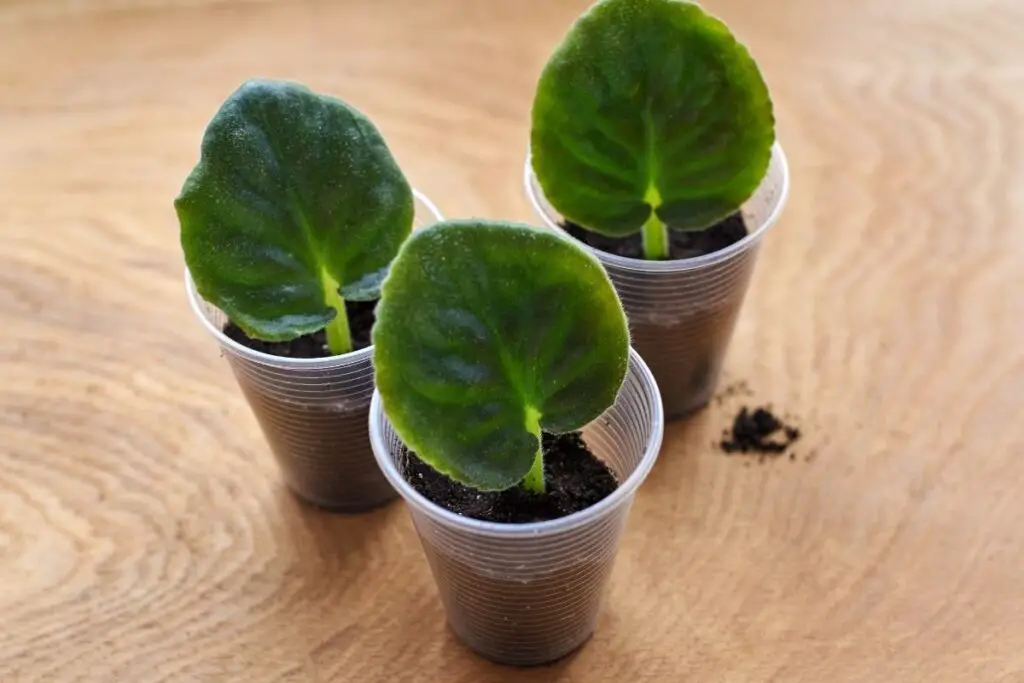
African violets prefer being slightly rootbound in their pots, and this is when they will produce offspring that will grow into a new plant.
You can also use a mature leaf of African violets for propagation. In this process, you have to remove a fresh leaf that you want to propagate. Then cut the leaf stem at a 45 degrees angle to about ½” in length.
Then take a small pot, fill it with fresh potting mix, and place the leaf stem inside the soil mix.
Then, you should cover the pot with a plastic bag and put it in bright light but no direct sunlight. The leaf will develop within a month, and after 2-3 months, you can transfer them to new pots.
Also read: How To Propagate African Violets? (By Leaf, Water & Soil)
African violets pruning
Pruning in African violets is done when their flowers wilt and fade or remove the dead, diseased, or overgrown parts of the plant.
Sometimes African violets can produce too many leaves. When the plant gets crowded with too many leaves, the leaves rub against each other and restrict their airflow. This, in turn, will lower the plant’s blooming rate.
You should cut back the dead leaves and stems and remove the dead, dying, and unhealthy blooms of African violets. Trim off the clumps of leaves that are preventing the growth of other parts of the plant.
African violets are often affected by diseases and pests, and you should prune the affected parts of the leaves at such times. Pruning in African violets doesn’t require sharp or bladed cuttings tools. You can do it with a pair of finely-tipped scissors.
Also read: How To Prune African Violets? (Step-by-Step Guide)
Problems of African violets
Nothing is more stressful than seeing your African violets struggle and not knowing the reason. Specific signals tell you that your plant is not doing well.
They can experience many problems, which can happen because of inadequate watering, wrong growing medium, or poor light.
Luckily most of the African violet problems are easy to fix. Keeping a check on your plants from time to time will help you to detect their problems.
This guide will take through the common problems they face and guide you with what you next to solve.
African violets can go through many issues such as:
- Not blooming
- Curling of leaves
- Browning of leaves
- Yellowing of leaves
- Drooping of leaves
- Wrong growing medium
- African violets Leggy growth
- Leaves turning white
- Brown spots on leaves
- Root rot issues
- Pest infestations
- Dust problem on leaves
Let us discuss each point in detail.
African violets not blooming
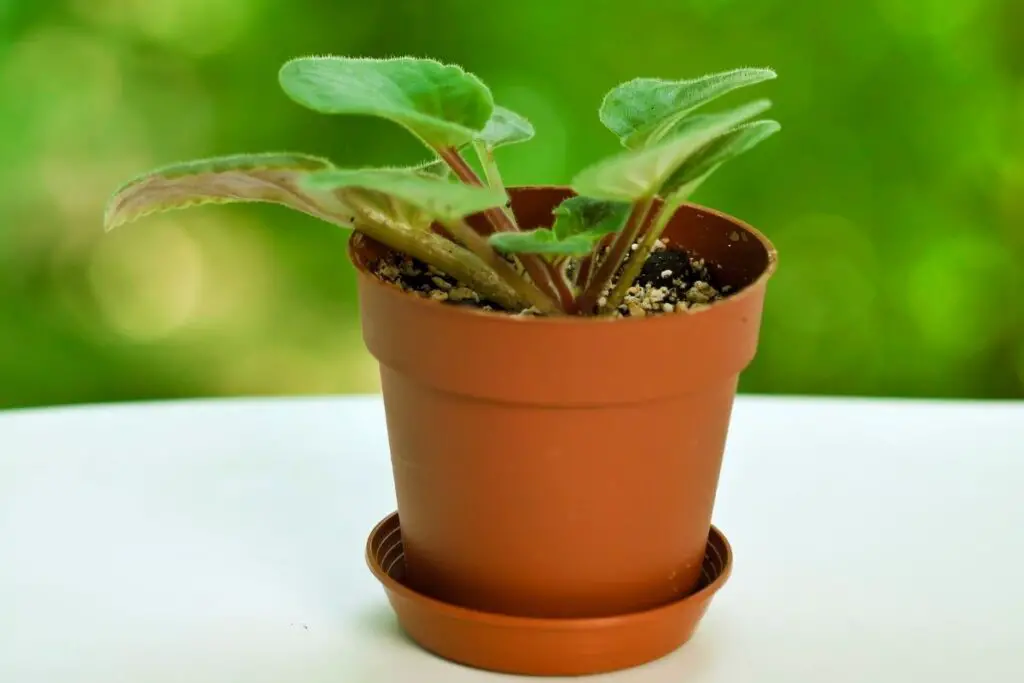
Sometimes the buds of African violets may fail to open, turn brown, and fall off. Once the blooms that come with the plant die, no more buds will grow.
One of the main reasons African violets are not flowering is due to the change in environmental conditions. Other problems can be poor light, wrong watering, low humidity levels, and using wrong fertilizers.
How to fix it?
To make the African violets bloom, you need to provide them with the right growing conditions.
- Provide African violets with at least 8 hours of indirect light every day during their growing season. You can increase the amount of light by shifting them to a brighter spot or by adding artificial light.
- Maintain room temperatures around 70°F during the day and 65-70°F at night.
- The roots are sensitive to both dry and well soil. So water them regularly and give them enough to keep the soil moist but not soggy.
- You need to maintain at least 40% of humidity around them.
- Use fertilizers that are specially made for African violets.
Also read: Why Is My African Violets Not Blooming? (Causes+How To Fix)
Curling of leaves
The broad leaves of African violets are their center of attraction, and if it’s starting to curl, it’s a severe problem. The two main reasons that their leaves curl are inadequate temperatures and too much sunlight.
If the temperature drops below 55°F, they will move into a self-preservation mood and will fold their leaves to prevent water evaporation through their leaves.
They prefer bright, indirect light, and when placed in hot direct sunlight, their leaves will curl. Another reason for curly leaves can be a mite problem.
How to fix it?
- You have to make sure that they are growing in cozy temperatures between 60 to 80 degrees. Keep them away from drafty windows and place them in pleasant temperatures.
- Never use cold water on the plant. It can shock them, and they will react by curling their leaves.
- Keep them away from direct sunlight. Place them on the window sill that supports indirect light.
- If they are infested with mites, you may need to dispose of the plant entirely as there is no other solution.
Also read: Why Are The Leaves On My African Violet Curling? (Problems+Solution)
Browning of leaves
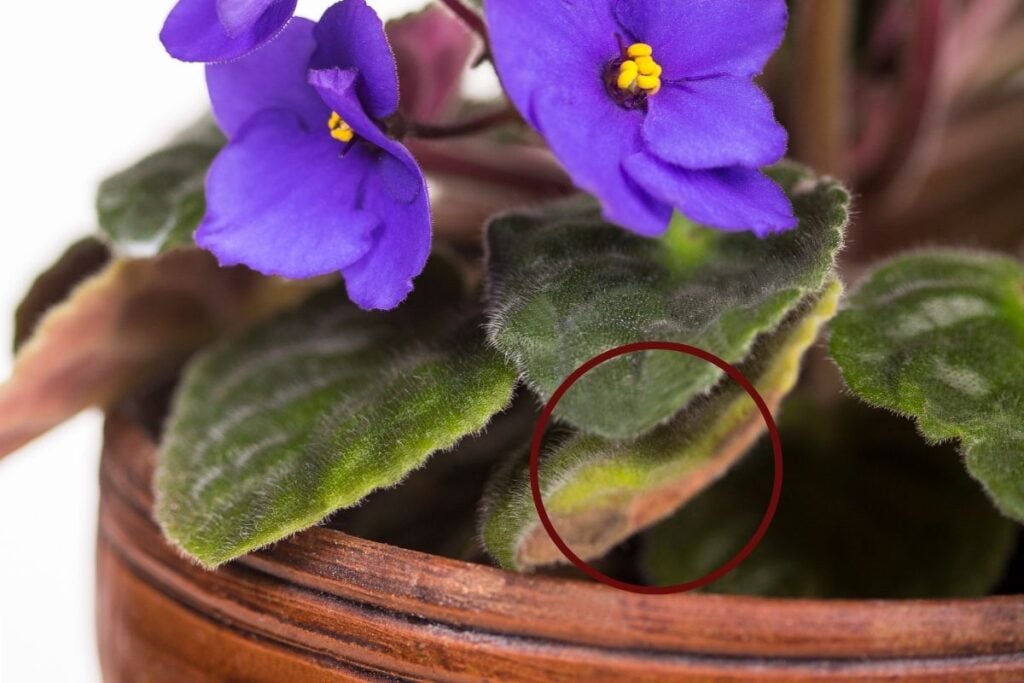
The leaves of African violets may turn brown and crispy. Several issues can cause this symptom in the plants. African violet leaves are sensitive to water, and if you wet them accidentally while watering, they will turn brown.
They will also have brown spots or sunburns if they are exposed to direct sunlight. You need to prune them as their leaves won’t recover again.
Overfertilization can be one reason for brown leaves in African violets. They have delicate root systems and will struggle if you over-fertilize them.
How to fix it?
- Never put water on the leaves while watering African violets. You can choose the bottom watering method for watering them.
- You have to examine the pot for any salt build-ups. If you notice yellow crystals on the pot’s rim, gentry flush the soil with water to remove those crystals.
- Use gentle, urea-free fertilizers to prevent nutrient build-up on the pot.
Yellowing of leaves
African violet leaves can turn yellow when it is under stress. The reason can be too much or too little water, poor lighting, inadequate fertilization, and pests or diseases that can cause yellow leaves in your plant.
Sometimes the leaves can turn yellow if you water with cold water. The cold water will shock the plant and kill the leaves’ cells, thus making them yellow.
The leaves will also turn yellow if it’s the end of their life cycle. Providing good care may delay the process, but it will turn yellow and drop at a certain point in time, and it’s not something to worry about.
How to fix it?
- The yellow leaves won’t recover, so trim the leaves and adopt a bottom watering practice in the future so that the leaves will not get wet while watering.
- Too much light can bleach the leaves and cause drooping. So place your plants on windows which will provide dappled or filtered light. A lace curtain on the window will give them the right light. Also, place the pot at least 1 foot away from the window.
- Keep the growing medium moist as both drought and waterlogging situations will cause yellow leaves. Check the soil surface before watering.
- They will need rich soil and regular fertilization in their growing season. You can apply organic compost or aged manure once a month to cover their nutritional needs.
Also read: Why Are My African Violet Leaves Turning Yellow? (Problems+Fix)
Drooping of leaves
The African violets’ leaves can turn droopy. This is a sign when the plant is not able to deliver nutrients properly to its cells.
Both underwatering and overwatering can cause droopy leaves. If the plant is underwatered, it won’t be able to keep its leaves firm and healthy.
Overwatering is a severe condition. If the African violets stay in oversaturated soil for too long, the root will not get enough air under the soil, creating prime conditions for root rot.
How to fix it?
- If the soil feels damp and mushy, remove the plant from the soil and check for root rot. If you find any root rot problem, trim off the damaged sections of the roots and repot the plant in a new fresh potting mix.
- Never skip watering your plant. Water them whenever the topsoil feels dry to the touch.
Also read: Why Is My African Violet Drooping? (Problems+Fix)
Wrong growing medium
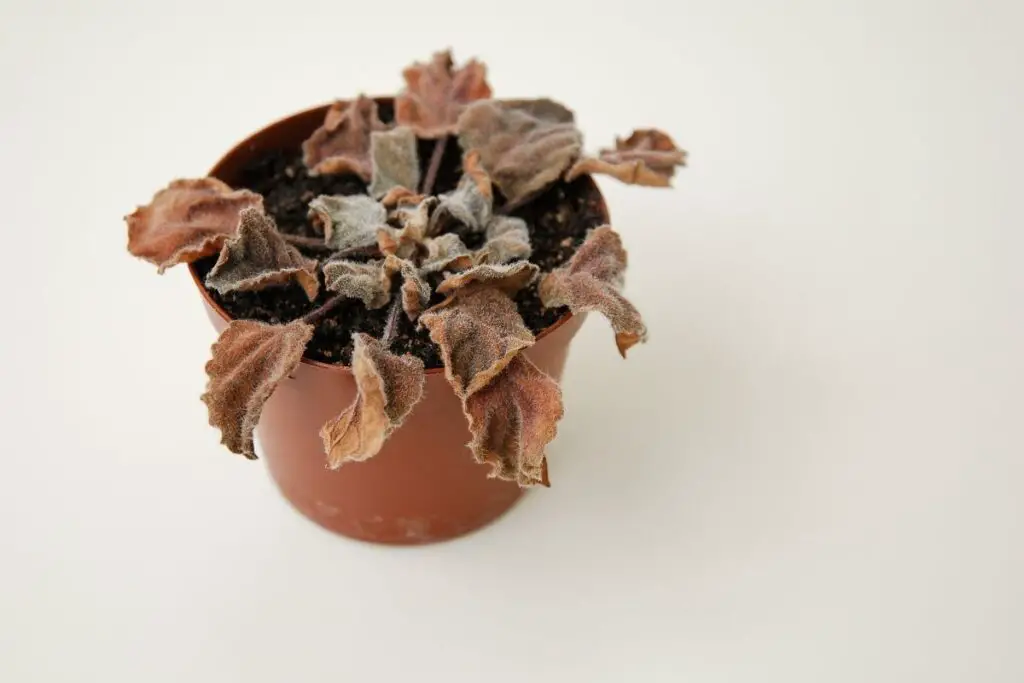
Often the wrong soil is the main culprit for many African violets problems. The plant prefers well-draining, aerated soil where the roots can get access to air.
If the soil medium is too heavy or dense, it will cause drainage problems to encourage root rot issues.
How to fix it?
- Get a well-aerated growing medium with a sound drainage system.
- You can make a potting mix by taking perlite and vermiculite, soil, and coarse sand in equal parts.
- Avoid clay or sand soil for African violets because clay soil will be too heavy, whereas loamy soil is not aerated enough.
Also read: What Kind Of Soil Is Best For African Violets? (+Best Soil Mix)
African violets leggy growth
African violets can become leggy. It can have long branches, less foliage, and space between the base of the plant and lower leaves. The long unsightly stems are a sign that the plant is getting on with age.
The new growth comes from the tip of the plant and will leave the bottom parts barren and leafless. When the bottom leaves die, no new shoots will replace them. Eventually, young plants can also become leggy as a result of mold or fungal infection.
How to fix it?
- To prevent African violets from getting leggy, you need to make sure that the growing medium is well fertilized. One of the leading causes of leaves falling at the base is poor nutrition. You can use organic slow-release composed or nitrogen-rich fertilizers for the plant.
- While repotting, use a slightly larger pot for African violets.
Also read: Why Is My African Violet Leggy? (Causes+Fix)
African violet leaves turning white
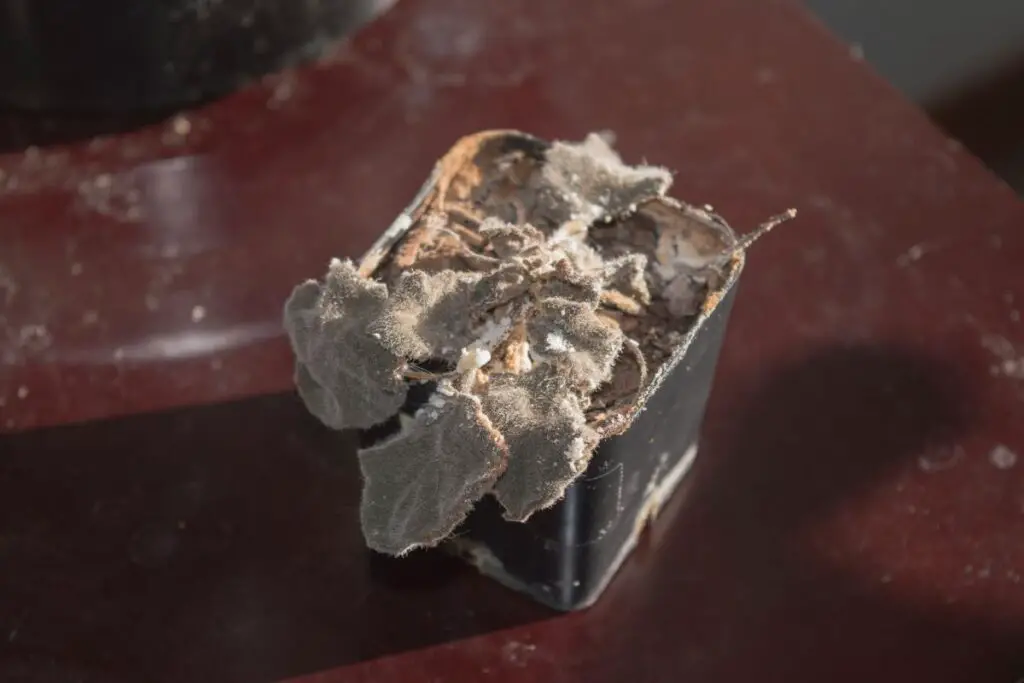
The leaves of African violets can turn white in winters, and you may notice white blotches in their leaves.
This mainly happens because of a fungal disease called white mildew. It is one common fungus that affects African violets. Cold temperatures and closed windows make an ideal ground for them to breed.
How to fix it?
If the plant has white blotches, remove the affected leaves and isolate the plant in a room with good air circulation while monitoring other additional outbreaks.
Also read: Why Does My African Violet Have White Spots? (Causes+How To Fix)
Brown spots on African violets
You may notice brown spots on African violets. It happens when you expose their wet leaves to direct sunlight.
If you find brown spots in the center of the leaves, sunlight is not the problem. It can happen because of tap water.
If you water them using tap water, they will have a brown spot. Tap water contains chloramines, and African violets are sensitive to it.
How to fix it?
If you suspect that the water you are using contains chloramines, then boil it for a short period to reduce the concentration of chloramines. Then bring the water back to room temperature before watering African violets.
Also read: Why Are My African Violet Leaves Turning Brown? (Problems+Fix)
Root rot
Root rot is a severe condition in African violets. It mainly happens due to overwatering. In the case of African violets, you need to be careful of the type of soil you choose for the plant and your watering patterns.
If the soil is wet for an extended period, Pythium ultimum, a fungus that lives in wet conditions, will feed on the roots. The roots of African violets will get damaged, shrink and fall, and the plant will die.
How to fix it?
Prevention is the best measure to root rot, and you can do it in the following ways:
- You can take a growing medium specially designed for African violets and not use regular soil to grow them.
- Water the plants regularly but lightly. The goal should be to the soil moist and not wet to activate the fungus.
- Do not let the soil dry out between watering as this can put the plant under stress.
- If the roots are severely affected, you may need to get rid of the plant entirely.
Pest infestations on African violets
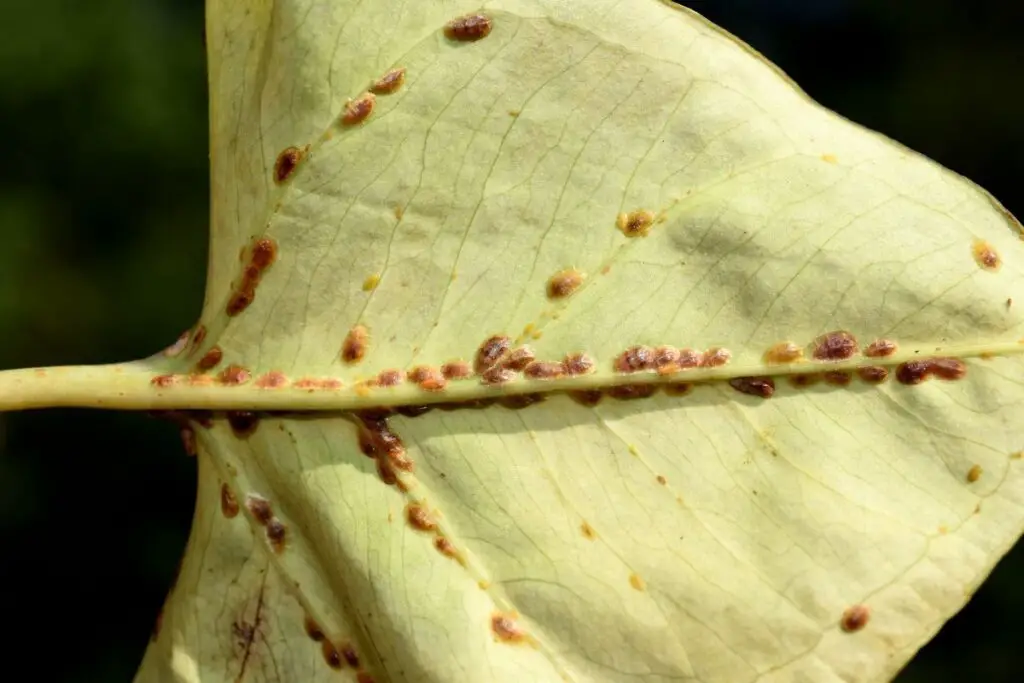
Pests such as soil mealybugs, aphids, thrips, and spider mites feed on African violets’ roots, foliage, and flowers. This pest will suck all the nutrients from the plant, making the plant weak and vulnerable.
The leaves of African violets will become spotted, speckled, or yellow when insects are present on them. Pest problems need to be addressed as quickly as possible before more damage occurs to the plant.
How to fix it?
- If your African violets are pest-infested, you should first isolate the plant and start the treatment immediately.
- Wipe the leaves of African violets with soap and water solution to get rid of pests.
- Spray pesticides and insecticides to kill and remove pests from the plant.
- You can use home remedies like neem oil and horticultural oil to remove pests.
- Prune of the infected parts of the plant, such as the infected leaves and stems.
Also read: How To Get Rid Of Bugs On African Violets? (Signs+Treatment)
Dust on leaves
The broad, glossy leaves of African violets can collect a lot of dust. This layer of dust will block the sunlight from reaching the leaves.
The leaves can develop dried water stains and needs to get cleaned up. Also, when you spray neem oil or any other spray on the African violets, it will develop a layer over leaves.
If you recently had pest infestations, the leaves of African violets will also develop a waxy coating over them, which you must remove.
How to fix it?
- You can use a dry paintbrush or soft cloth to clean their leaves.
- You can use a moist, soft cloth to wipe the dust from the leaves gently.
FAQ
Are African violets high maintenance plants?
African violets are such plants that can brighten up your indoor garden with minimal care.
You just need to check on their requirements and provide them with needed water, sufficient light and protect them from the cold, and you will get rewarded with healthy flowering plants.
How do I identify my African violets are healthy?
African violets thrive and are known to bloom throughout the year. If your plant has vibrant flowers, strong growth, and fuzzy leaves, it indicates that they are healthy and doing well.
It’s your responsibility to monitor the plant regularly for any leaf problems, flower loss, or soil issues and correct any inconsistency to keep them healthy.
Are African violets poisonous to pets?
African violets are not considered poisonous, but they are not very safe either. The plant proves to be a little toxic if consumed in high doses.
The plant contains saponins, which are natural plant toxins found in African violets, and this toxic substance can cause diarrhea, vomiting, or cramping to sensitive pets.
They are non-toxic to pets like cats and dogs. Consuming African violets by cats and dogs can cause indigestion, but it is toxic to small pets like rabbits and Guinea pigs.
It can cause abdominal discomfort and gastric problems. It is always better to keep your pet away from African violets.
Source: Wikipedia, African violet: Classical breeding, African Violet Society of America, In vitro propagation of African violet, University of Florida, North Dakota State University, The University of Georgia.
